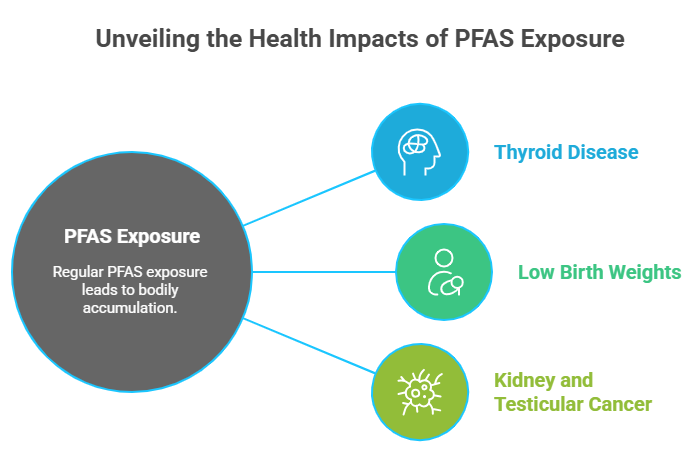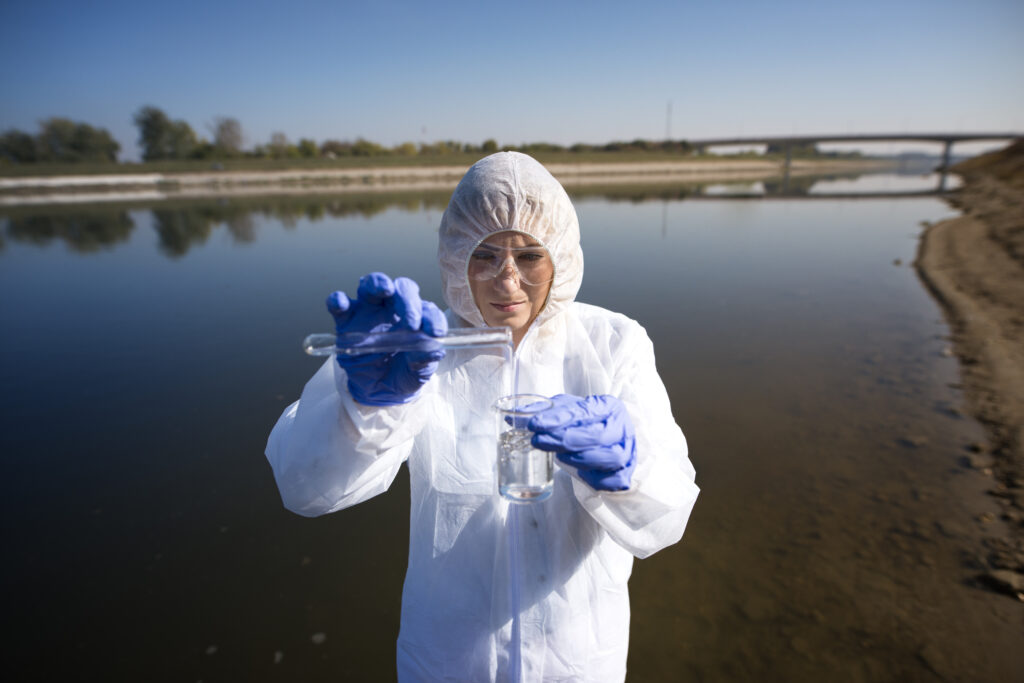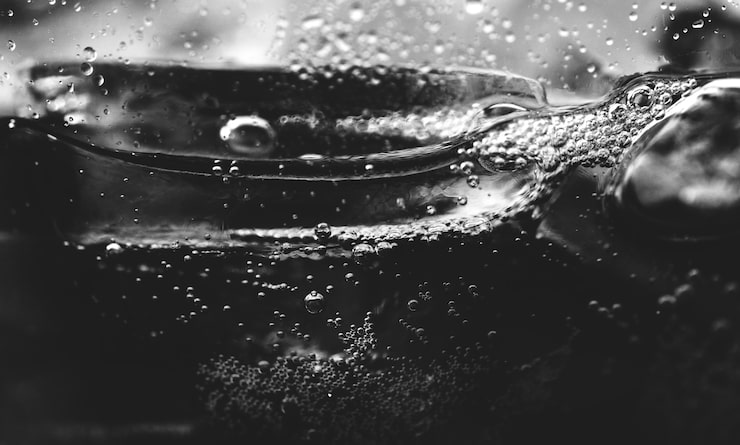PFAS, or per- and polyfluoroalkyl substances, are not one but thousands of chemicals made artificially. These chemicals are used for their ability to repel water and oil, temperature resistance, and to reduce friction. In a nutshell, these chemicals are used in our daily lives in different products.
In Australia, approximately 85% people have been detected to have PFAS in their blood. It is alarming data because the chemical has been found more in the older population than in the younger population.
You might ask, “How does its exposure harm human beings?” Well, researchers have found that the chemicals might affect the reproductive system and increase blood pressure among pregnant women. Exposure to these chemicals among children might create developmental issues, low birth weight, increased risk of cancer, and many other issues.
Let’s take a look at where the chemicals come from in the human body.
| Product Type | PFAS Use |
|---|---|
| Non-stick cookware | Heat-resistant coatings |
| Stain-resistant carpets | Water and stain repellents |
| Fast food wrappers | Grease-proof linings |
| Makeup and skincare | Long-wear and waterproof formulas |
| Firefighting foams (AFFF) | Chemical suppression agents |
Table 1: Common Consumer Products Containing PFAS
Apart from such usage of PFAS in our daily lives, industrial use of the substance is also one of the major reasons for PFAS contamination in water. PFAS are used in the Teflon industry to manufacture non-stick or non-stain products.
How PFAS Contaminate Water Supplies
When the non-biodegradable substance is used in different factories, it gradually leaks from the factories and blends into the environment. The carbon-fluorine bonds of PFAS are so strong that they cannot be broken down, so they accumulate in the environment.
Once it comes into contact with the environment, you can literally find its traces in all the living organisms in that area. You would be surprised to know that the remediation cost of such sites is so high that even authorities have decided to leave it as it is.
So, when the PFAS chemical gets into the water sources that are used for human beings, it can cause harm. Municipal water sources, private wells, lakes, and other natural sources can be contaminated by PFAS.
Health Effects of PFAS Exposure
When the PFAS in water is used regularly in your daily work, you unknowingly accumulate the substance in your body. Over time, the accumulated PFAS cause serious issues in your body.
Thyroid Disease
Perfluoroalkyl and polyfluoroalkyl substances disrupt the natural functions of thyroid hormone. Studies suggest that PFAS have a severe effect on the function of the endocrine system, which disrupts the natural level of thyroid hormone in our bodies. It may lead to hypothyroidism and disrupt the natural course of brain development.
Low Birth Weights
These forever chemicals can be transformed from the mother to the foetus. It has been found that exposure to the chemicals is associated with a high risk of lower birth weight.
Kidney and Testicular Cancer
Scientists still need more research work to arrive at the absolute conclusion regarding its carcinogenic element. But they have observed that a greater incidence of kidney cancers has been seen among workers in PFAS-producing plants.
Moreover, it has been seen that air force members who have been exposed to firefighting foams in airports or in other military facilities are diagnosed with testicular cancer.

Global and Australian Contamination Hotspots
Several locations in Australia have been overly exposed to PFAS. The Friends of the Earth Australia has managed to build a database that has identified approximately 450 detections of PFAS in 66 locations across Australia. The wide scale of detection of the chemical is so dangerous that it has been termed as the ‘next asbestos’.
Some of the names of such locations include RAAF Base Williamtown, RAAF Base Amberley, Perth Airport, and many other areas.
How to Test for PFAS in Your Water
If you want to know how to avoid PFAS, the first step is to test the water that you regularly use. Look for an NATA-accredited laboratory in your locality that uses liquid chromatography along with mass spectrometry, in short, LC-MSMS.
It is better to test your water sample in a professional NATA-accredited laboratory. It will offer you an accurate result, so that you can take immediate measures to protect yourself from the harm of PFAS.
Can You Remove PFAS from Drinking Water?
Yes, PFAS can be removed from drinking water. You would have to use a specific water treatment process to keep your drinking water free from harmful chemicals. These processes may include:
Activated Carbon Treatment
Activated Carbon is one of the most used materials to purify water from organic and synthetic compounds. The main reason for its use in water purification is that it is a porous material. Moreover, its large surface area makes it an ideal material to be used to absorb synthetic materials like PFAS.
ION Exchange Treatment
The ion exchange resins are made of hydrocarbons that have proven to be efficient in removing PFAS and other impurities from water. The resins mainly come in two categories – positively charged anion exchange resins (AER) and the negatively charged cationic exchange resins (CER). These positively and negatively charged resins attract ions of PFAS with opposite charge. Thus, you can remove PFAS-related impurities from the drinking water.
Reverse Osmosis
Another effective way to remove PFAS from drinking water is reverse osmosis. Reverse osmosis membranes are approximately 90% effective in removing most PFAS from drinking water. With this process, you can also remove shorter-chain PFAS.
| Method | Effectiveness | Maintenance |
|---|---|---|
| Activated Carbon | Moderate–High | Medium |
| Reverse Osmosis | High | High |
| Ion Exchange Resin | High | Medium |
| Boiling | Not effective | N/A |
Table 2: PFAS Water Filtration Methods
What Is Being Done About It?
As more research is being carried out, people are coming to know about the harmful impact of PFAS. In Australia, Europe, and other parts of the world, surveys are done to identify PFAS-contaminated sites.
In the USA, the chemical has been categorized as a hazardous substance. With more evidence of it causing cancer among human beings, the substance can now be considered to be a carcinogenic element.
What You Can Do as a Homeowner or Consumer?
To avoid PFAS contamination, you can test your drinking water at least once a year. If you live in an identified PFAS zone, you should take immediate measures.
Next, use certified water filtration equipment that effectively removes PFAS from your drinking water. At the same time, when you are purchasing cookware or cosmetics, look for the ‘PFAS Free’ label. It will make sure that you are not exposed to the harmful emissions.
If you want to know whether you live in a PFAS-contaminated zone in Australia, check out this map.
Final Thoughts: Awareness Is the First Line of Defence
PFAS is considered to be a global environmental and health challenge. The wide range of its use in industries and product manufacturing makes it more dangerous due to its contamination. It would be better for you to be alert and take preventive measures to stay away from contamination. Test your water for the signs of PFAS and install equipment to remove the substance from your water.
Frequently Asked Questions
How Can PFAS Get Into Drinking Water?
PFAS are non-biodegradable chemicals, and their fine particles travel in our environment. If the water we drink is contaminated with PFAS from any industrial plant, it will end up in your drinking water. Besides, PFAS used in cookware or drinking pots might go into the human body.
How Can I Be Tested for PFAS?
If you have concerns that you are exposed to PFAS, you can get yourself tested. The doctor might ask you to do some blood tests to see if there are any traces of PFAS in your blood.
How to Reduce PFAS Exposure in My Drinking Water?
To reduce the exposure of PFAS in your drinking water, you need to first know if there are traces of PFAS in your drinking water. If yes, then use a water filtration system to remove PFAS particles from the water. Also, try to identify the sources of contamination and ask the local government to take necessary measures. Finally, use drinking glasses or cookware that are free of PFAS.
Can We Not Ban the Use of PFAS?
PFAS is indeed toxic and non-biodegradable, but it is used in a wide range of materials. Fire-fighting foams that use PFAS have already been banned. However, substitutes of PFAS (that are not harmful) are being researched to use in the manufacturing of goods.





